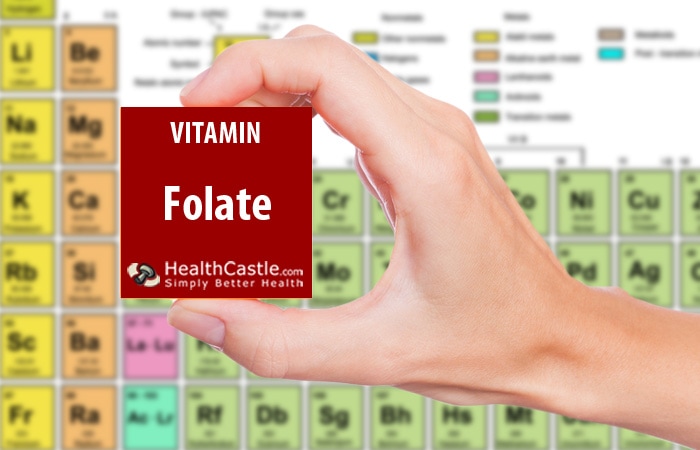
Written By: Sofia Layarda, MPH
Title: Master of Public Health
Alumni: University of California, Berkeley
Last Updated on:

Folate is a B vitamin that occurs naturally in some foods. As a supplement, or when added to fortify foods, it is known as folic acid.
Table of Contents
Folic acid from supplements or fortified foods is more bioavailable than the naturally occurring folate in foods. Therefore, the recommended dietary intake is defined as mcg (micrograms) of dietary folate equivalent (DFE). This takes into account that the average daily intake of a North American will include both folate from food and folic acid from fortified foods such as breakfast cereal, pasta, and some flours.
1 mcg DFE = 1 mcg food folate OR 0.6 mcg folic acid from fortified foods (or dietary supplement taken with foods) OR 0.5 mcg folic acid supplement taken on an empty stomach.
| Age Group | Recommended Dietary Allowance (RDA) per day1 | Tolerable Upper Intake (UI) Levels*2 |
| Adults | ||
| 19 years and up | 400 mcg DFE | 1,000 mcg |
| Kids and Youth | ||
| 1 to 3 years | 150 mcg DFE | 300 mcg |
| 4 to 8 years | 200 mcg DFE | 400 mcg |
| 9 to 13 years | 300 mcg DFE | 600 mcg |
| 14 to 18 years | 400 mcg DFE | 800 mcg |
| Special Considerations | ||
| Pregnant women 14 to 18 years old | 600 mcg DFE | 800 mcg |
| Pregnant women 19 years and up | 600 mcg DFE | 1,000 mcg |
| Lactating women 14 to 18 years old | 500 mcg DFE | 800 mcg |
| Lactating women 19 years and up | 500 mcg DFE | 1,000 mcg |
*The upper intake levels apply only to the amount of folic acid obtained from supplements or fortified foods. High intakes of folate from food sources do not appear to cause adverse effects.
There is no recommended dietary intake for infants from birth to 12 months. Instead, the adequate intake is used, which reflects the mean folate intake of healthy breastfed infants in the United States.

Folate is involved in many important processes in the body, including DNA/RNA synthesis, proper cell division3, and metabolism of amino acids. This means it has a huge role to play during periods of rapid cell division and growth4, such as when a fetus is growing in the womb. It is an essential nutrient important in the prevention of neural tube defects in a developing fetus5. Neural tube closure occurs early in pregnancy (around the third to fourth week), in some cases before a woman knows she is expecting a baby, so it is important to ensure sufficient folate levels even before pregnancy.
One of the reactions involving folate is the conversion of the amino acid homocysteine to methionine6; a high homocysteine level in the blood has been associated with a higher risk of cardiovascular disease. In the presence of folate and Vitamin B12, homocysteine can be converted back to methionine. As folic acid levels in the blood rise, homocysteine levels drop. Large-scale observational studies have shown a reduction in the risk of stroke with folic acid supplementation, but not a reduction in the risk of heart attack.
Folate is also important in the production of healthy red blood cells7. When there is insufficient folate, the red blood cells produced are larger than normal but have a shorter life span than normal red blood cells. The type of anemia associated with folate and/or Vitamin B12 deficiency is megaloblastic anemia.
This list includes both foods that are naturally high in folate and foods that have been fortified with folic acid (marked with a *). Both the United States and Canada fortify a wide range of cereals and grains, so fortified foods are an important contributor of folic acid to the average North American diet.
| Food | Amount of Folate |
| Breakfast cereal, Special K, 1 cup* | 676 mcg DFE |
| Breakfast cereal, Cheerios, 1 cup* | 336 mcg DFE |
| Lentils, cooked, 1/2 cup | 179 mcg DFE |
| Chickpeas (garbanzo beans), cooked, 1/2 cup | 141 mcg DFE |
| Black beans, cooked, drained, 1/2 cup | 128 mcg DFE |
| Avocado, raw, 1/2 fruit | 121 mcg DFE |
| Asparagus, boiled, drained, 4 spears | 89 mcg DFE |
| Broccoli, chopped, boiled, 1/2 cup | 84 mcg DFE |
| Spaghetti, enriched, cooked, 1/2 cup* | 84 mcg DFE |
| Romaine lettuce, shredded, raw, 1 cup | 64 mcg DFE |
| Spinach, raw, 1 cup | 58 mcg DFE |
| Brussels sprouts, boiled, drained, 1/2 cup | 47 mcg DFE |
| Green peas, boiled from frozen, 1/2 cup | 47 mcg DFE |
| Cantaloupe, cubed, 1 cup | 34 mcg DFE |
| Kale, raw, chopped, 1 cup | 21 mcg DFE |
*Fortified with folic acid
Because folate is a water-soluble B vitamin, boiling or cooking in liquid will cause a portion of the folate to be lost to the cooking liquid. So if you are cooking your leafy greens, choose minimal liquid methods (such as quick stir fry) and/or use the cooking liquid.
Given that folic acid–fortified foods contribute, in some cases, a much higher dose of folic acid than natural food sources of folate in a given serving, is getting too much folic acid a concern? Very high doses of folic acid may mask the neurological damage resulting from Vitamin B12 deficiency; the folic acid “corrects” the megaloblastic anemia, but the neurological damage continues. Extremely high doses of folic acid may also increase the risk of certain types of cancer in some people. For now, aim to obtain your daily intake of folate from a wide variety of foods, not just by relying on fortified foods. Food sources of folate tend to be high in other desirable phytonutrients that are powerful antioxidants, and it is unlikely that you would overdose on folate from naturally occurring sources.
In the United States: The daily value for folate is 400 mcg DFE8, which is the same level as the DRI for adults. The % daily value gives you an idea of how much folic acid is in the food you eat. However, the % daily value number is only required by the FDA for foods that have been fortified with folic acid, so it is unlikely you would see food labels on fresh vegetables or fruits that display this information.
The number you see on the Nutrition Facts label is a percentage calculated by dividing the amount of folic acid in one serving of the food by the daily value. To use an example from the food table above, a cup of Cheerios that contains 336 mcg of folic acid would have 84% of the daily value (DV) for folic acid.
In Canada: The Daily Value (DV) for folate is 400 µg DFE9, which matches the DRI for adults. The % Daily Value on a Nutrition Facts label indicates how much folate a serving of food contributes toward your daily requirement.
Vitamin B12: Mega doses of folate may mask Vitamin B12 deficiency.
HealthCastle has strict sourcing guidelines. We reference peer-reviewed studies, scientific journals and associations. We only use quality, credible sources to ensure content accuracy and integrity.
Alumni: University of California, Berkeley – Sofia believes in bringing back fun and pleasure into everyday eating. She loves cooking, and is constantly experimenting with ingredients, creating recipes and trying them out on family and friends. Her latest interest lies in finding realistic and practical ways of environmentally-friendly food/eating habits.
folate, folic acid, micronutrient - vitamins, vitamin b, vitamins